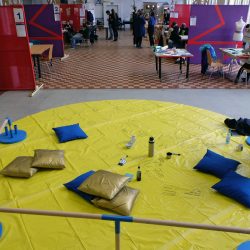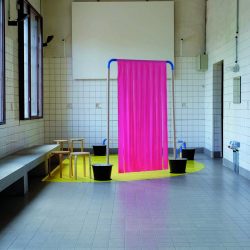Dialogische Strukturen
Description
The "dialogical structures" can be described as a setting that questions political hierarchies at the spatial level and facilitates negotiations in smaller groups. They are nomadic and are used in different places. Part of the "dialogical structures" are both the physical elements and the interpersonal strategies of the negotiations.What is the Topic?
The current political situation in Europe (and worldwide) provides an opportunity to reflect on the forms of political negotiations and social organisation. What do parliaments and political arenas look like today? And: What could they look like in the future? The "dialogical structures" create a framework for thinking about such things together. The design already takes up thematic insights and transfers them to physical space. The theme also includes: How do we come together for a negotiation? How can a negotiation be structured to avoid or reverse (classical) hierarchies? How can those affected negotiate about things that concern them themselves?
Why does it look like this?
Inspired by street furniture of public space where Grassroot movements began (Occupy, Arab Spring, Municipalism), the structures are designed according to principles that favour a low hierarchical gathering. The circle is the most inclusive form for smaller groups. In contrast to individual seating, the bench is a connecting element. Sharing the material also potentially reinforces a sense of togetherness. In addition, the unpadded bench means that participants have to constantly correct their positions. While the comfortable armchair tempts to egomaniacal stubbornness, the uncomfortable bench provokes the willingness to think along. The pink curtain leads into a special and intimate room.
What is special?
The "dialogical structures" are spatial sketches and therefore speculative: they are not defined by a specific structure, but by being able to act context-specifically. At a dgtf conference, we discussed with designers how a neighbourhood parliament could be designed; in Dortmund with residents what a neighbourhood parliament would have to offer in their neighbourhood; and at PACT Zollverein with urbanists how one could negotiate directly in urban space. In all these cases, the "dialogical structures" are firstly the visible, constructed elements, but secondly also the invisible, the psychological and performative ones. Two examples: The participants read the introduction out loud one after another (relaxation of the voice, each has already said something). And: the discussions first take place in pairs and then in large groups (movement, concentrated exchange, variety stimulates the mind). The "dialogical structures" are both theoretical reflection and real laboratory: they do not solve problems, they generate wishes.
What is new?
In a speculative scenario we approach these named questions with participants. It is not about how e.g. a neighbourhood parliament could be integrated into the existing everyday life – to be an additional burden, an additional task for each individual –, but about finding out which conditions for society as a whole must be created so that everyone has the opportunity to take part in negotiations and to stand up for themselves and others. The participants meet at eye level and the imagined future is practised directly. The structures can be changed, supplemented or taken apart, they are site-specific.






